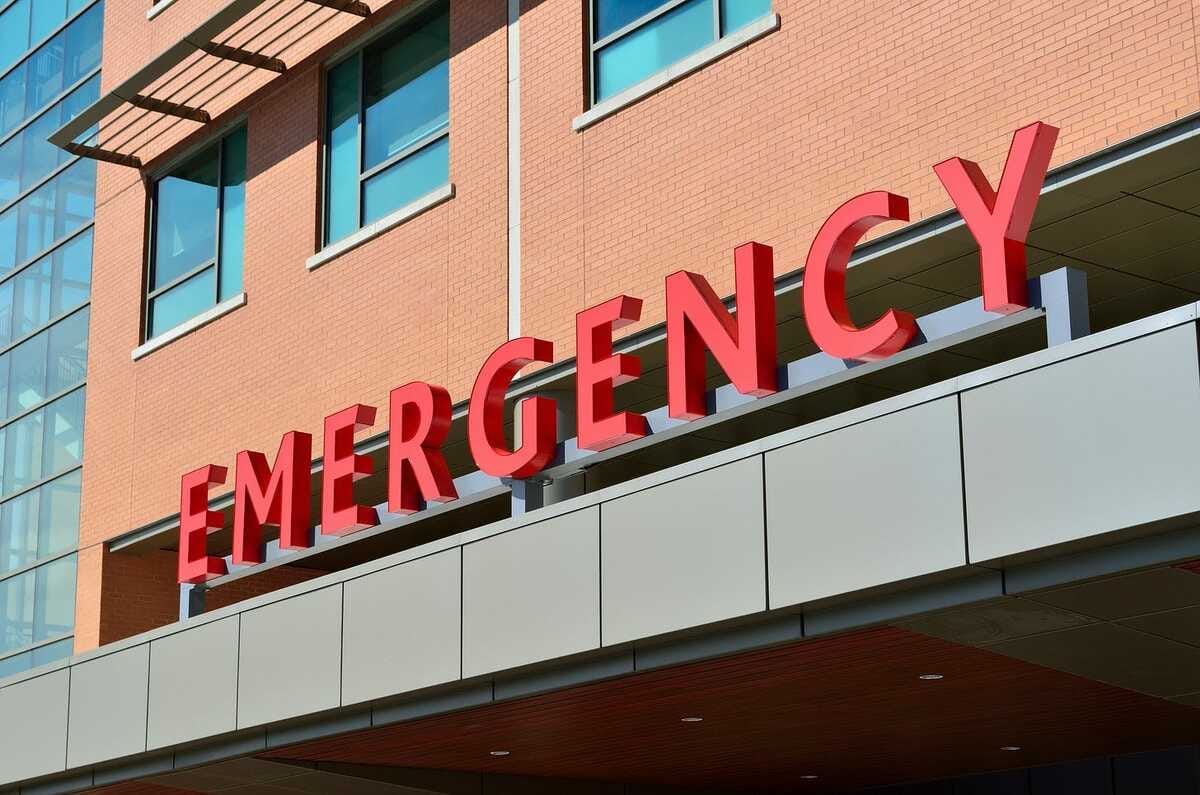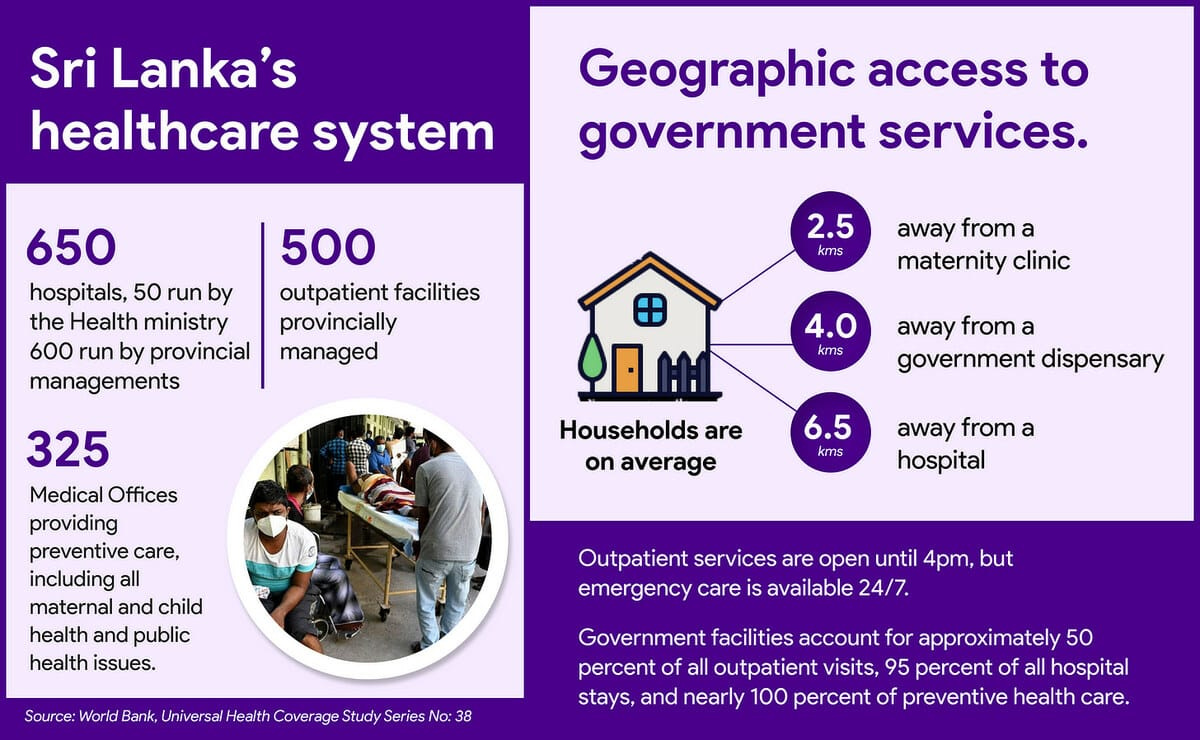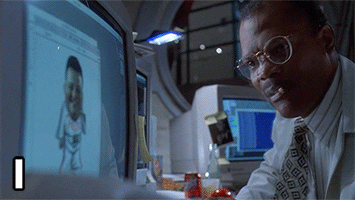Lanka on life support
The island nation’s nearly century-old healthcare system, which was nearing universal coverage, is unravelling
Good morning! A big hello to readers who signed up this week. Welcome to The Intersection, The Signal's weekend edition. This weekend we talk about Sri Lanka's crumbling healthcare system and the lessons it holds for other developing nations. Also in today’s edition: we have curated the best weekend reads for you.
If you enjoy reading us, why not give us a follow at @thesignaldotco on Twitter and Instagram.

The first alarm bells started ringing towards the end of 2021, when patients at Colombo’s National Cancer Institute, popularly known as Apeksha Hospital, stopped getting vital life-saving medicines. Soon, reports started flowing in from other hospitals, too, as they struggled to provide patients with medicines and equipment required for treatments, surgery, and therapy.
“Shortages in the healthcare sector have affected hospitals at all levels in the country, from the National Hospital of Sri Lanka in Colombo to most rural hospitals,” Dr Chamil Wijesinghe, spokesperson of the Government Medical Officers’ Association (GMOA), told The Intersection.
The Auditor General’s Special Report on Shortage of Pharmaceuticals in Government Hospitals said that, as of May 2022, Sri Lanka had run out of 311 medicines, including 190 essential and vital drugs. Another 310 medicines would last for not more than three months. The report also found that hospitals did not have 2,156 essential surgical items. It identified Sri Lanka’s foreign-exchange crisis as the immediate cause of shortages. Four months later, the crippling shortages continue to deprive Sri Lankans of vital medicines and critical healthcare.
Sri Lanka’s experience speaks to the risks from global economic shocks that people living in small and vulnerable economies are exposed to. What began as a foreign-exchange crisis ballooned into a substantial shortage of essentials: food, energy, and medicines. While the island nation’s troubles were not created overnight, the meltdown threatens to unravel a publicly-funded, near-universal healthcare system that in some ways predates even the United Kingdom’s famed National Health Service (NHS). What was once touted as a model for other developing nations is crumbling.
“There are few, if any other, low- or middle-income countries that have simultaneously achieved strong health outcomes, good financial protection, and low cost,” Owen Smith, a senior economist at the World Bank, wrote in a 2018 study (pdf) of Sri Lanka’s health coverage.
Sri Lankan households are on average just 2.5 kilometres from a maternity clinic, four kilometres from a government dispensary, and 6.5 kilometres from a hospital. About 93% of the population is within 15 kilometres of a hospital. Outpatient services are open until 4 pm, but emergency care is available 24x7. Government-run facilities account for 95% of all hospital stays and nearly all preventive healthcare.
The public healthcare system was established in the 1920s but was sought to be expanded to the whole country only after a malaria pandemic in 1934-35. Entirely public-funded with a focus on well-dispersed services and the need to provide protection from financial distress due to illness, the service has stood the test of time as a low-cost way of delivering equitable medical care. Although it accommodates private hospitals as well and does not have pro-poor carve-outs, it has worked out to be beneficial to the poor.
That system is now on life support as Sri Lanka scrambles for aid from multilateral institutions and friendly countries to put together its broken economy.
The roots of the crisis
Largely dependent on tea, textile and spice exports, and tourism, Sri Lanka began slipping into a crisis when its foreign-exchange reserves dipped to precarious levels in early 2021. That would have been okay if its debt was not at an astronomical $51 billion—a result of war, populist policies, and a desire for power projection by previous regimes. With key western markets in the doldrums, Sri Lankan exports too failed to pick up. But despite seeing the writing on the wall, the mandarins in Colombo failed to plan and prioritise.
That meant, at the peak of power shortages, doctors were conducting surgeries with flashlights. A baby died of jaundice because her father could not find petrol for his vehicle to take her to the hospital in time.

The GMOA compiled a report on this and presented it to the government, says Wijesinghe. “Our main finding was inefficiencies in procurement and distribution, and lack of coordination. The responsible parties are the SPC, SPMC, the Health Ministry, and the National Medicines Regulatory Authority.”
Sri Lanka imports about 85% of its pharmaceutical requirements through the State Pharmaceutical Corporation (SPC). The rest is manufactured by the State Pharmaceuticals Manufacturing Corporation (SPMC). It imported pharma products worth about $500 million in 2020, half of it from India.
According to the Auditor General’s Special Report, the country spent LKR 73,638 million (~$200 million) on medical supplies in 2021, hardly enough for its needs. That means shortages occur, leading to emergency purchases—an “easy pathway to corruption,” says Wijesinghe.
For instance, the rabies vaccine was in short supply this year because of a delay in procurement. An estimate for the year’s requirement was done in March 2021, but the order was only given this year. Wijesinghe says there can even be fake shortages to enable emergency purchases.
“The forex crisis this year has played a big role in aggravating the shortage,” says Amala De Silva, professor of economics at the University of Colombo. As the Sri Lankan rupee loses value, the prices of imported medicines are rising steeply.
The unravelling
Colombo resident Ruwani Fonseka has Type 1 diabetes and requires two types of insulin every day. “The cost of one of these increased from LKR 1,300 to LKR 2,370 for a 10-day supply, while the cost of the other increased from LKR 938 to LKR 2,000 for a 10-day dose,” says Fonseka. “I used to buy enough insulin for one month. But now, I can only find about ten pens at a time.”
Drug prices have shot up between 100% and 300% in the past three to four months, says Wijesinghe. Inflation rose to 70.2% in August, with food prices going up 84.6% since the beginning of this year, according to the Central Bank of Sri Lanka. The Sri Lankan rupee crashed from ~LKR 200 against the US dollar in March to ~LKR 360 now.
Sri Lanka has a poor understanding of its disease burden, says University of Colombo professor De Silva. There are no comprehensive annual forecasts of drug needs. When patients are asked to purchase drugs from private pharmacies, they desist because they cannot afford them, she adds. “This means that they do not comply with proper medical advice. They may use medicines on alternate days or just buy some of the drugs in the prescription.”
Health requirements are primarily forecast on a “cash basis”, where funds are allocated only when the expenditure is incurred. That leads to procurement delays. Funds are handed out by the health ministry and its respective state ministries, or through the councils of the country’s nine provinces. However, there are allegations that the process is disorganised and lacks an assessment mechanism.
Even private hospitals are dependent on the state apparatus for medical supplies. Dr Ananda Kuruppuarachchi, president of the Association of Private Hospitals and Nursing Homes, says there are around 200 private hospitals in the country, with a majority concentrated in the Western Province.
“We are also facing pharmaceutical and energy shortages due to power cuts and fuel shortages,” says Kuruppuarachchi. “We anticipate a shortage of labour too, in the near future, as professionals are leaving the country.”
The private sector depends largely on the SPC and registered importers to fulfil pharmaceutical requirements, since private hospitals do not engage in any imports. “There is no proper system established to record estimated needs. Most private hospitals only have enough stocks for about three months at a time,” adds Kuruppuarachchi.
That could worsen the healthcare crisis. As demand for medicines grows, shortages could increase. Lengthy waiting lists for specialised and advanced care, out-of-pocket costs, and disparities in financing for the sector are pushing the public towards expensive private medical care. That could, as GMOA’s Wijesinghe says, lead to corruption and weaken the public healthcare system that was built over a century.
Back to building
The WHO and World Bank estimate that Covid-19 “halted two decades of global progress towards UHC”. Half a billion people were pushed deeper into poverty because they had to pay for healthcare from their pockets.
With its population ageing fast, Sri Lanka needs to invest more in healthcare. Sri Lanka achieved total fertility rate (pdf) of 2.1—known as replacement fertility at which births are enough to keep the population stable—in 1994. In comparison, India achieved it only this year. The proportion Sri Lankans aged 65 and above has risen from 3.7% in 1970 to 12% in 2021. The country urgently needs to devise prevention strategies for non-communicable diseases (NCDs) and personalised care for those living with NCDs. WHO estimates that NCDs cause 75% of deaths in the country.
But Sri Lanka barely has the money to keep the system running. Only 6% of expenditure in the government’s budget for 2022 is earmarked for health. A 2018 policy brief by the Institute for Health Policy notes that, at 1.5% of GDP, Sri Lanka was a “low spender on health” compared with other countries.
“Some people are optimistic that within a year or so, the situation may ease,” says economist De Silva. At the moment, Sri Lanka is surviving on the Indian credit line and assistance from the World Bank, WHO, and ADB.
“Donations are only short-term, ‘plaster’ solutions,” says GMOA’s Wijesinghe. The country’s healthcare sector has delivered outcomes comparable with some developed countries at a low cost. It must build on those gains rather than squander a century’s work.
ICYMI

Last night a DJ saved my life: Nod if you get the Indeep reference, stay for the best profile you’ll read in months. For this longread in The New Yorker, Ed Caesar tailed Solomun, the DJ who rules Ibiza, the nightlife capital of the world. You’ll learn how the island got its name, how Solomun escaped the trenches (he once had to pick between a kebab and pack of cigarettes), and how he turned Ibiza’s legendary club, Pacha, around. Bonus: house music recommendations you won’t see elsewhere.
The New Radio?: Last week, as Adnan Syed walked out of jail, podcasts—specifically Serial—had their moment again. But narrative-driven shows are getting rarer by the day. This Vulture piece explains why. Sample this: “Given the industry’s fixation on celebrity casts and habit of outsourcing its true-crime research to Wikipedia, it’s hard to contend that podcasting has done much reinvention of late.”
That said, The Prince by The Economist, is worth a listen. It traces Xi Jinping’s ascent from the fields of rural Shaanxi to the Zhongnanhai.
Form and function: Toronto’s housing downturn is so bad that the world’s preeminent architect, 93-year-old Frank Gehry, is going on promotional tours in his hometown to sell units in his eight-story condominiums. It’s not all bad, though. Gehry’s legacy—which includes the Walt Disney Concert Hall in LA and Spain’s Guggenheim Museum Bilbao—is enough to withstand project cancellations amidst economic upheavals. His genius (he can make stainless steel-cladded skyscrapers look like balled up aluminium foil) has much to do with it. A must-read for architecture fans.
Road to glory: Second-hand cars are having their moment in Japan. So much so that even SoftBank is getting in the game. A global shortage of semiconductors and a supply-chain disruption for parts and materials has meant that new cars are in short supply. Earlier, used cars in Japan were mostly sold to emerging markets. Now, that’s no longer the case. This story in the Financial Times has all the details.
Risky hacks: Healthcare is a common target for ransomware gangs around the world. It’s a growing concern in the US, where hackers are paralysing computer networks at hospitals. This is a serious problem in healthcare, where even a minute’s delay can lead to life-threatening consequences. The attacks slowed down during the pandemic thanks to the pleas of Lawrence Abrams, founder of BleepingComputer.com, an influential news website dedicated to ransomware. But they’re now on the rise again.
Enjoy The Signal? Consider forwarding it to a friend, colleague, classmate or whoever you think might be interested. They can sign up here.
We recently got funded. For a full list of our investors, click here.
Want to advertise with us? We’d love to hear from you.
Write to us here for feedback on The Signal.



